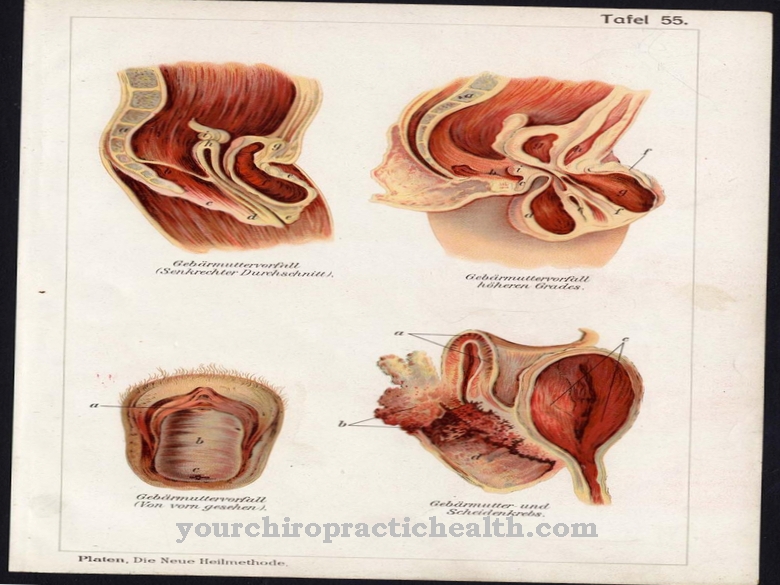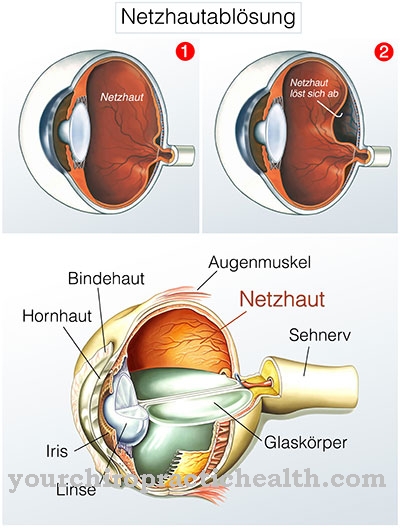A Intercostal neuralgia causes severe pain in the chest and back area. It is not uncommon for the nerve pain to be caused by an infection with herpes zoster (shingles). The treatment is usually medicated and depends on the underlying disease.
What is intercostal neuralgia?

© hawanafsu - stock.adobe.com
People with intercostal neuralgia suffer from nerve pain that originates between the ribs or along the chest wall. The chest cavity is surrounded by the chest wall made of bone and tissue.
The intercostal nerves run along the chest wall and are responsible for the neuralgia. The exact location of the pain differs from case to case. The pain intensity is also different for each patient. Typically, the pain is long-lasting and pulling.
Sufferers report that the pain increases when they cough or sneeze. Even deep breaths are usually associated with increased pain intensity. In this way, intercostal neuralgia can be differentiated from heart pain, as no increase in pain can be observed here when inhaling deeply.
causes
Intercostal neuralgia is not an independent disease, but a symptom of the underlying disease.There are various reasons why neuralgia occurs in the intercostal space. All possible causes are associated with mechanical damage to the nerves between the ribs.
Intercostal neuralgia can be caused by broken ribs, in which parts of the bone press on a nerve. In addition, excessive wear and tear on the vertebral bodies of the spine can pinch nerves, causing neuralgia. Intercostal neuralgia in connection with herpes zoster, also known as shingles, occurs particularly frequently. This viral disease causes inflammation of the nerves, which can also affect the intercostal nerves.
This viral disease causes inflammation of the nerves, which can also affect the intercostal nerves. Intercostal neuralgia can also be caused by tuberculosis or tumors in the lungs. In some cases, after surgery to open the patient's chest, post-thoracotomy syndrome occurs, in which people suffer from neuralgia of the intercostal nerves.
Symptoms, ailments & signs
Intercostal neuralgia manifests itself primarily as severe pain in the chest and back. Typical of the syndrome is a rapid spread of pain, with the symptoms mostly appearing in a belt or ring shape. They are limited to one or two parts of the body, such as the area between the ribs and the chest wall or the right upper abdomen.
The pain itself is felt to be pulling by those affected. It can last for several days, weeks or even months and increase in intensity over time. The symptoms increase with sneezing, coughing and loud laughter. In some patients, violent attacks of pain occur again and again, combined with sweating, dizziness and panic attacks.
The intercostal neuralgia can also cause abnormal sensations such as tingling or numbness. Bad posture, which can be recognized by an unusual posture, are also characteristic. In the long term, the bad posture in turn provokes pain reactions and functional disorders of the holding apparatus.
In the advanced stages, intercostal neuralgia leads to restricted breathing and ultimately to persistent shortness of breath. If the paralysis is not treated, there is a risk of permanent nerve damage. The chronic pain and restricted mobility favor the development of depression and other mental illnesses.
Diagnosis & course

If you have intercostal neuralgia, it is important to be able to diagnose it quickly to prevent the pain from becoming chronic. In general, neuralgia is only spoken of after about three days with nerve pain.
If the symptoms do not go away on their own by then, a doctor must be consulted. The attending physician first takes a detailed anamnesis. He particularly asks about the type of pain and its location. This is followed by a palpation examination to determine exactly where the pain is localized. If the patient is sensitive to pain in certain places where intercostal nerves run, an intercostal neuralgia can be diagnosed.
However, this is only the determination of one of the symptoms of the underlying disease. In the further course of the diagnosis, the underlying disease must be determined. In some cases, the doctor orders a myelography, i.e. a contrast X-ray of the spinal canal. Chest x-rays or ultrasound examinations can also be used for diagnosis. How intercostal neuralgia progresses depends on the underlying disease. Usually, however, the course is to be assessed as positive.
Complications
With intercostal neuralgia, most patients typically have severe pain in the back and chest. This pain has a very negative effect on the patient's quality of life. Furthermore, pain at rest can also lead to sleep problems. Not infrequently, in addition to pain, breathing difficulties also occur.
Those affected can also lose consciousness. Furthermore, the breathing difficulties can lead to fear of death. It is not uncommon for paralysis or other disorders of sensitivity to occur in the affected regions. Furthermore, the patients suffer from abnormal sensations and are therefore considerably restricted in their everyday life. The permanent pain often leads to depression or other psychological upsets. As a rule, the disease will not progress positively without treatment.
The pain can be limited with the help of pain relievers. Furthermore, tension has to be released, whereby there are no further complications. However, the symptoms cannot be completely limited in every case. Life expectancy is usually not reduced by intercostal neuralgia. If necessary, the person concerned is then dependent on various therapies.
When should you go to the doctor?
Since intercostal neuralgia can be a symptom of various diseases, a quick diagnosis of the underlying disease is necessary. Depending on what other complaints occur to those affected, they should either see their family doctor or a specialist after a few days. Early diagnosis is also important, as in some cases the pain can otherwise become chronic. Doctors speak of intercostal neuralgia if the symptoms persist for more than three days without significant improvement. If the symptoms do not improve after this period, those affected should consult a doctor.
However, if the patient starts to experience symptoms such as fear of death, severe nerve pain, or shortness of breath, or if the symptoms continue to worsen, it is advisable to seek medical treatment immediately. In rare cases, the neuralgia can have serious causes that may require rapid surgical intervention. If left untreated, intercostal neuralgia can last for several months, depending on the disease. Rapid treatment and diagnosis can reduce the duration of the symptoms to a few days, depending on the cause.
Doctors & therapists in your area
Treatment & Therapy
Treatment for intercostal neuralgia depends on the underlying condition. Basically, there are a number of treatment options that the doctor and the patient can choose for each individual case.
If the pain is severe, pain medication is given first. This is not a causal therapy, but brings relief to those affected in acute cases. Nonsteroidal anti-inflammatory drugs are particularly suitable for treating pain in intercostal neuralgia. This type of pain reliever works particularly well with neuralgia, as it spreads its effects to the periphery of the body. Muscle relaxants are also often used to relieve any tension in the muscles.
Sometimes people suffer from extreme pain where conventional pain relievers have no effect. In these cases, the attending physician will administer strong pain relievers that act on the central nervous system. Morphine, an opioid, is administered particularly frequently. There is also the option of local anesthesia, which guarantees freedom from pain for a limited period of time. For many doctors, local anesthesia is preferable to opioids, as strong painkillers put a strain on the body and cannot be administered without side effects.
In addition to pain therapy, there is causal therapy. Antivirals are given for shingles. If an intercostal nerve is trapped, physiotherapy can help in many cases. Exercises are worked out with which the painful area can be relieved. In some cases, the exact cause of the intercostal neuralgia is unknown and treatment is limited to pain management.
You can find your medication here
➔ Medicines for painOutlook & forecast
The prognosis of intercostal neuralgia is linked to the underlying disease. Since the symptoms develop due to an existing health irregularity, intercostal neuralgia should not be understood as an independent disease. The symptoms disappear as soon as the underlying disorder recovers. A general view of the further development process cannot be given. There is an individual assessment and assessment for a possible healing success.
In severe cases, secondary diseases occur. These can be physical as well as psychological in nature. If there is the possibility of treating the existing nerve damage quickly and without further complications, the prospect of a full recovery is good. In the case of slight broken ribs, regeneration is documented in most patients after the healing process of the bone damage has been completed. Simple fractures usually heal and cause only a few long-term complaints. If the disease progresses unfavorably, however, chronic complaints are also possible.
If the patient suffers from a tumor, a life-threatening situation can arise. If the tumor can be completely removed, alleviation of the symptoms is conceivable. However, the cancer can become fatal without treatment or at an advanced stage.
In the case of viral diseases, the prognosis is favorable as soon as the pathogens die off as a result of drug therapy. A recurrence of the complaints over the life span cannot be ruled out.
prevention
Intercostal neuralgia is not a disease in its own right, it is merely a symptom. Because of this, there are few prophylactic measures that can be taken. If there is pain in the intercostal space, a doctor should be consulted quickly so that the underlying disease can be diagnosed as early as possible.
Aftercare
In most cases, direct follow-up measures for intercostal neuralgia are severely limited or are not available to those affected. First and foremost, the disease must be recognized by a doctor at an early stage so that early treatment can also be initiated. Independent healing cannot occur, so that those affected with intercostal neuralgia are always dependent on medical treatment by a doctor.
The treatment itself takes place with the help of various measures of physiotherapy and physiotherapy. Those affected can repeat many of the exercises themselves at home, which speeds up the treatment. When taking pain relievers or other medication, those affected should always follow the doctor's instructions. It is also important to ensure that it is taken regularly and that the dosage is correct.
Since the intercostal neuralgia has a negative effect on the muscles of the person concerned, no more physical or stressful activities should be carried out in order to avoid unnecessary strain. Help and support from your own family can also have a positive effect on the further course of the disease. As a rule, intercostal neuralgia does not reduce the life expectancy of those affected.
You can do that yourself
In addition to drug treatment, physiotherapeutic measures are also useful in the case of intercostal neuralgia, which are supported by the person affected by exercises and other measures at home. Breathing and stretching exercises help with chest pain and improve overall wellbeing. In some cases, alternative methods such as massages or pain point pressure are also useful.
If sleep or psychological problems occur in the course of the illness, therapeutic advice is indicated. However, the person affected should not only contact doctors and psychologists, but also inform friends and relatives about their illness. In the treatment of intercostal neuralgia, the support of the personal environment is an important factor.
If the paralysis and sensory disturbances increase, the sick person must take measures to compensate for the restricted mobility. This can be the use of a walking aid, but also a disabled-friendly facility or even accommodation in a nursing home. The course of the disease is always decisive. The development of the individual symptoms should be recorded in a complaint diary. In this way, an individual therapy can be developed together with the medical team, which usually enables the person affected to continue living relatively symptom-free.





.jpg)



















.jpg)


